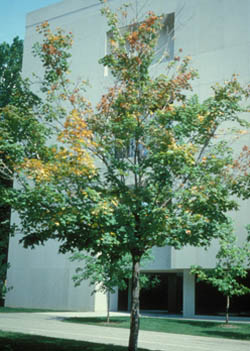Maple Decline | |
|---|---|
| August 28, 2007 | |
|
Maple decline is a term that is often used loosely by many diagnosticians to refer to more than one condition. There seem to be more reports of maple decline now than 20 years ago, possibly because it has become more widely accepted. Maple decline does not involve a consistent pathogen. An individual tree may exhibit symptoms caused by a combination of factors, with pathogens usually as secondary invaders. Stress factors might include mechanical injury, weather stress, girdling roots, deep planting, salt injury, nutrient imbalance, grade changes, compaction, herbicide injury, or many other factors. Maple decline usually includes branch tip death, defoliation of enough leaves to give the tree a sparse look, and a slow decline of the tree over a number of years. The image shows a maple in decine, with trunk injury as an obvious stress factor. Site stress and ultimately root rot were also involved.  Courtesy of L. Rhodes, The Ohio State University. Maple decline affects primarily sugar maple (Acer saccharum), Norway maple (A. platanoides), and red maple (A. rubrum); but other species are also susceptible. Maple decline may not be something that can be “controlled,” but often it can be prevented or avoided by selecting the tree species or variety best suited to a planting site, followed by giving the tree proper care and maintenance. Learn how to avoid girdling roots; plant at the proper depth, and use mulch over the root system for a healthier root environment. Maple decline is difficult to confirm because there is no single pathogen that can be isolated and implicated as the cause. Instead, the diagnosis follows a long fact-finding process and elimination of various factors. These two sources of information on maple decline can be found on the Internet:
|